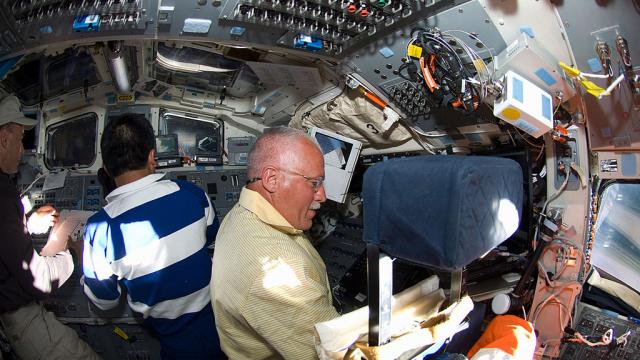We know that astronauts’ bodies are heavily impacted by their time in space, but as more of them come back to Earth following longer and longer stays without gravity, more issues are going to arise.
Astronaut John Phillips (right) on the Space Shuttle Discovery flight deck (Image: Getty Images)
Take for example the case of astronaut John Phillips, who was aboard the International Space Station in 2005. According to a Washington Post report, he began experiencing problems with his eyes while in space, but was reluctant to say anything. The man had perfect eyesight when he left Earth, but during his post-flight physical, doctors found that it had deteriorated to 20/100 in six months.
Over time, researchers discovered that around 80 per cent of astronauts are affected by what became known as visual impairment intracranial pressure syndrome (VIIP). They believe it has to do, like most physiological problems astronauts face, with the lack of gravity.
Researchers know that fluid that normally builds up the lower half of the body (due to gravity) tends to flow upward, causing increased pressure on the brain. For example, a two-litre bottle’s worth of liquid shifted to Scott Kelly’s brain during his time in space. This can cause extra pressure on the back of the eyeballs, which could flatten, pushing the retinas forward and distorting sight. Phillips’ optic nerves were inflamed and had choroidal folds.
This is only a working theory, as scientists haven’t been able to test for it without space-like conditions. They’re also not sure how long the condition lasts, or even if it’s temporary.
However, studies are being done in space to see if maintaining a normal flow of bodily fluids helps with nearsightedness. Kelly and other astronauts would frequently don the Russian Chibis suit, which is a pair of bulky pants that suck out the air around the wearer’s legs to simulate gravity. More studies need to be done, but John Charles, the chief Scientist at NASA’s Human Research Program, said that restoring that flow showed that it did have an effect on the eye.
This research just adds to the already long list of health problems that astronauts face during time in space. Besides the lack of gravity messing with an astronaut’s bodily fluids, it can mess with someone’s sense of up and down, since the brain can’t figure out where the ground and ceiling are. There’s also the chance that an astronaut’s bones can become brittle and break upon re-entry, hence these custom-moulded seats that keep them in place.
